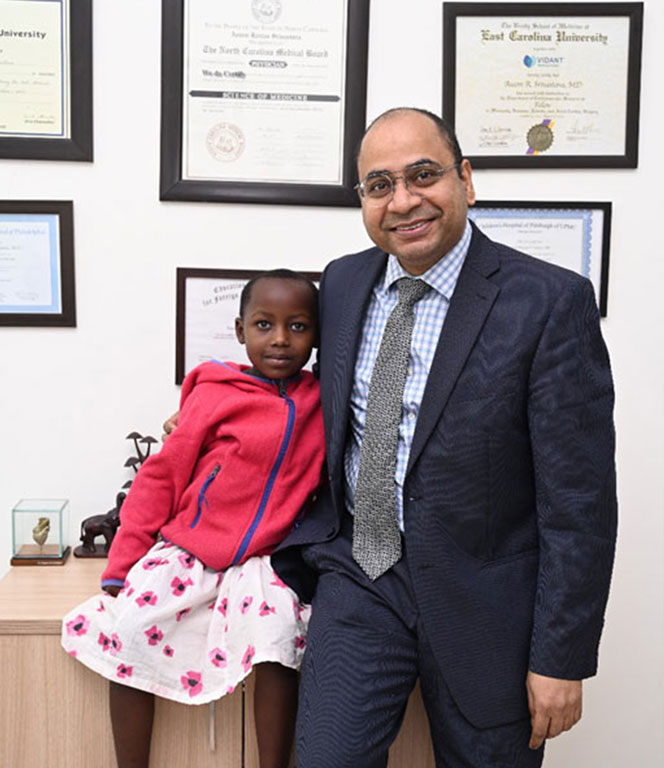What is Tetralogy of Fallot?
A condition caused by a combination of four heart defects that are present at birth.
Tetralogy of Fallot is a common heart condition in children that are blue (cyanosis). It is a combination of four birth defects in the heart.
Tetralogy of Fallot (TOF) is a heart disease in children that are blue (cyanosis). There are four different problems in the heart:
1. Pulmonary stenosis (PS)
PS is a narrowing (stenosis) at or around the pulmonary artery that blocks the flow of blood from the heart (right ventricle) to the lungs. This means that blood cannot go from the heart to the lungs easily.
2. Ventricular septal defect (VSD).
A VSD is a Hole (defect) in the wall (septum) separating the pumping chambers of the heart (the right and left ventricles). Because of this ‘Hole in the Heart’ blue blood in right ventricle mixes with the red blood in left ventricle
3. Overriding aorta.
Oxygen-rich blood is pumped to the body through a big artery (called Aorta) from the left chamber of the heart. An overriding aorta occurs when the aorta is located partly over the right chamber of the heart (right ventricle), so that instead of receiving just the oxygen-rich ‘Red’ blood from the left ventricle it also receives oxygen-poor ‘Blue” blood from the right ventricle.
4. Right ventricular hypertrophy (RVH).
RVH is a thickening (hypertrophy) of the walls of the right ventricle. The walls thicken because the right ventricle is pumping at high pressure to try to get blood to the lungs through the narrow pulmonary artery.
Why do the surgery?
During surgery we will repair all of these four problems.
Children with TOF do not have enough blood going to the lungs because of the narrowing around the pulmonary valve (pulmonary stenosis) and so do not have enough oxygen in their blood.
If the pulmonary stenosis is left untreated, the right ventricle muscle gets thicker (right ventricular hypertrophy) to try to push blood to the Lungs. When the right ventricle muscle is too thick, it also blocks the flow of blood to the pulmonary artery, and the amount of oxygen in the child’s blood continues to decrease.
If surgery is not performed in time about 25% babies with this heart condition will lose their life by the age of 1 year and about 60% children will be lost by the age of 10 yrs.
Surgical procedure
Surgery is usually done when the child is between six and twelve months old- however, depending on the child’s condition the operation can be done earlier or later. The surgeon makes an incision down the front of the chest to get access to the heart. The heart is connected to a cardiopulmonary bypass machine. This machine takes over the heart’s work of pumping blood so the surgeon can enter the heart to repair it.
The repair may consist of the following steps:
- 1. Fixing the narrowing around the pulmonary valve (the pulmonary stenosis). The pulmonary artery may be cut open where it is too narrow, and a patch may be placed there to make the artery wider. If the narrowing is located at the pulmonary valve, it may be necessary to cut open the valve to make the repair.
- 2. Cutting out some of the muscle in the right ventricle if it has gotten too thick and is blocking the flow of blood to the pulmonary artery.
- 3. Fixing the ‘Hole in the heart’ (ventricular septal defect). The hole(s) between the right and left ventricles are usually closed with a patch made of Dacron™. The surgery will take an average of four to six hours from start to finish.
Risks and benefits of the surgery
The benefit of the surgery is for the child to have a better functioning heart. This would mean that the child will not be blue anymore and his/her growth and development will be better. In addition, the risk of death and heart failure are also avoided.
Risks of surgery include: bleeding, infection, stroke, organ damage, requirement for a temporary or permanent pacemaker, or possibly death. However, the total the risk of these occurring is 2 to 3% or less.
What to expect during the hospital stay?
The length of the hospital stay usually varies from five to 10 days, and this will depend on how quickly the heart recovers.
For a few days following surgery, we will take care of your child in the ICU. In the Intensive Care Unit, we will keep a watch on the child’s Heart Rate, Blood Pressure, Respiration and other organ functions. To avoid frequent interruptions in the care of your child, there is a restriction to visitors, however, parents can visit the child.
Going home
The hospital will supply specific discharge instructions, medicine list and dosages and Operation notes. All instructions from the hospital, cardiac surgeon, and cardiologist should be strictly followed. The child should get back to his or her normal routine upon arrival at home. For the first week, the child may wish to take more frequent naps or wake up occasionally at night- and this is normal. The child should be seen by us after 3-6 days after discharge from the hospital.




